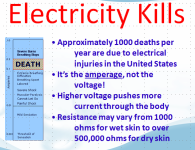leitmotif
Member
I am starting a new thread since I feel this is too large a tangent from another thread entitled "UL safe voltage"
http://www.plctalk.net/qanda/showthread.php?p=447296&posted=1#post447296
BACKGROUD I am in a group that is starting out training the future electric driven land or sea mobile apparatus - anything between garden tractor or railroad locomotive or ship - whether by land or sea if it is propelled with an electric motor that is our area.
One of the hats I wear is Safety. As you may remember I have a MS and 20 years field experience in that and as many years in electrical. So I get to write the electrical safety class notes and I also get to write the safety manual.
BACKGROUND
The DC voltage source is batteries - you CANNOT turn them off - thus always hot work. We will be working anywhere between one cell ie 3 or 4 volt in case of lithium up to 325 or 350 VDC for a complete battery. Yes we will have to teach students how to safely make all connections starting with cell one and ending up at cell 120 or so. The high voltage traction battery is not bonded to vehicle frame and is therefore floated ie not "grounded" (using common vernacular).
CHALLENGE
find one number that sets the "die or live" point for DC voltage.
Or maybe more accurately at what point do I say
below XX it is OK to work bare handed,
over XX work with hot gloves,
I think the reality is
there is NO single magic number and
if push comes to shove I may end up setting history by finding it and putting to an end all arguments on this matter.
In a way that will be disappointing since there will no longer be a "start point" for some really neat to watch dog fights among safety guys over this issue.
In YOUR minds
1. should I always require properly insulated tools. I may have my answer but I want to hear yours.
2. What do you think my magic number is?
Thanks for the insight
Dan Bentler
http://www.plctalk.net/qanda/showthread.php?p=447296&posted=1#post447296
BACKGROUD I am in a group that is starting out training the future electric driven land or sea mobile apparatus - anything between garden tractor or railroad locomotive or ship - whether by land or sea if it is propelled with an electric motor that is our area.
One of the hats I wear is Safety. As you may remember I have a MS and 20 years field experience in that and as many years in electrical. So I get to write the electrical safety class notes and I also get to write the safety manual.
BACKGROUND
The DC voltage source is batteries - you CANNOT turn them off - thus always hot work. We will be working anywhere between one cell ie 3 or 4 volt in case of lithium up to 325 or 350 VDC for a complete battery. Yes we will have to teach students how to safely make all connections starting with cell one and ending up at cell 120 or so. The high voltage traction battery is not bonded to vehicle frame and is therefore floated ie not "grounded" (using common vernacular).
CHALLENGE
find one number that sets the "die or live" point for DC voltage.
Or maybe more accurately at what point do I say
below XX it is OK to work bare handed,
over XX work with hot gloves,
I think the reality is
there is NO single magic number and
if push comes to shove I may end up setting history by finding it and putting to an end all arguments on this matter.
In a way that will be disappointing since there will no longer be a "start point" for some really neat to watch dog fights among safety guys over this issue.
In YOUR minds
1. should I always require properly insulated tools. I may have my answer but I want to hear yours.
2. What do you think my magic number is?
Thanks for the insight
Dan Bentler
Last edited:




